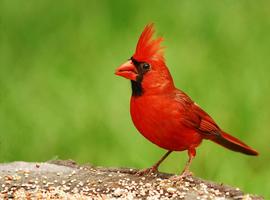 | Back to e-WV
| Back to e-WV
 The West Virginia Encyclopedia
The West Virginia Encyclopedia
 | Back to e-WV
| Back to e-WV
 The West Virginia Encyclopedia
The West Virginia Encyclopedia

The northern cardinal, once known to most West Virginians as simply ‘‘red bird,’’ became our state bird in 1949. It was chosen for the male’s brilliant red coloration and crest and the lovely, although more subtle colors of the female, its statewide distribution, the beautiful, cheery song heard from early spring into summer, and its propensity to live near our dwellings and visit backyard bird feeders.
Spring courtship rituals often begin with the male offering the female a tidbit of food. The nest is made of twigs, vines, leaves, and small roots, lined with hair and fine grass. It is usually built close to the ground, in shrubs, or small trees. The female lays two to five eggs which are buff-white with dark marks. She sits on the eggs for 12 to 13 days and the young leave 10 to 11 days after hatching. There may be two, three, even four broods a season; the male cares for the existing brood while the female incubates the eggs of the next.
Cardinals eat 51 species of insects, 33 kinds of wild fruits, and 39 different weed seeds. To attract them to a feeder offer black oil sunflower or safflower seed.
Written by Kathleen Carothers Leo